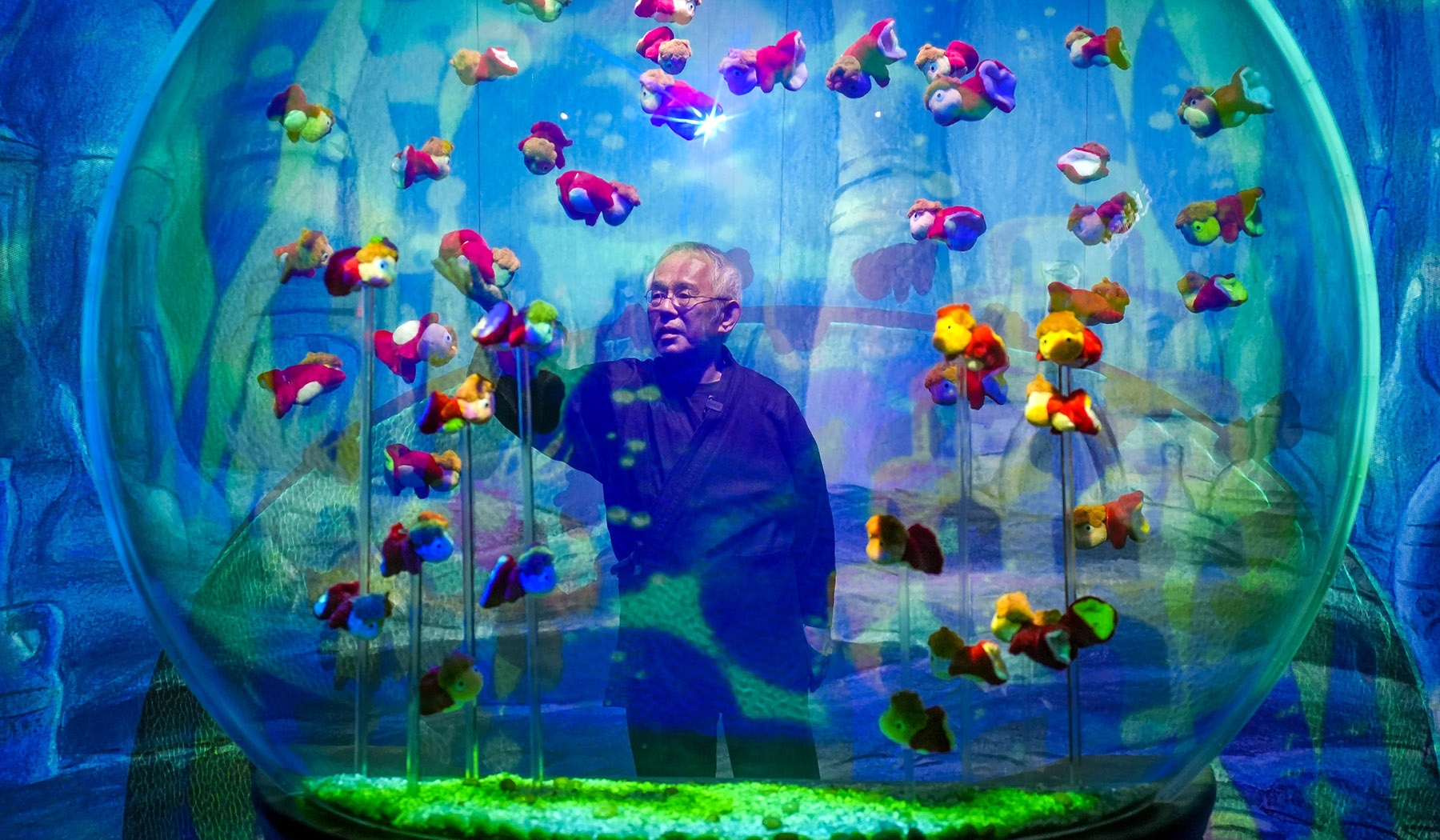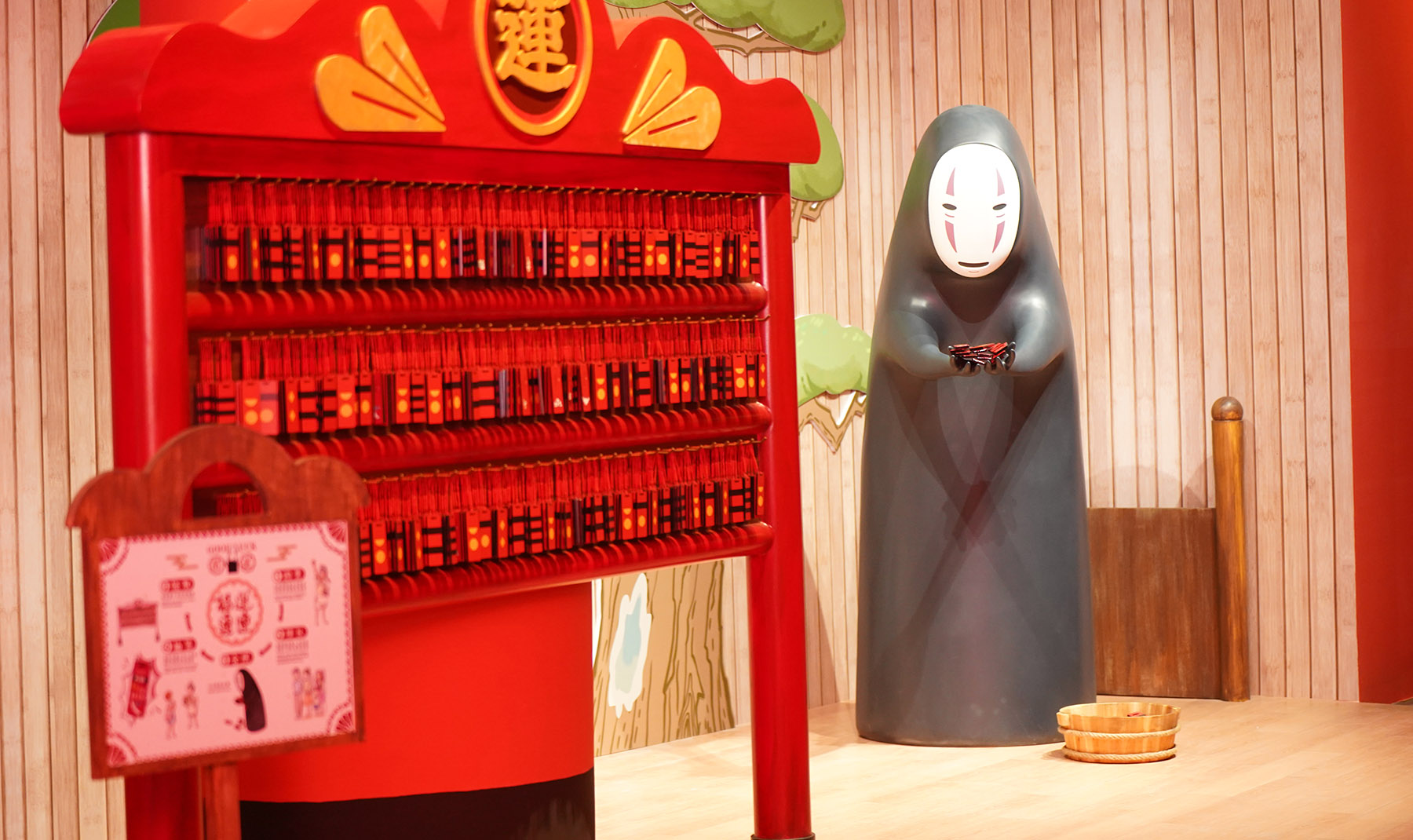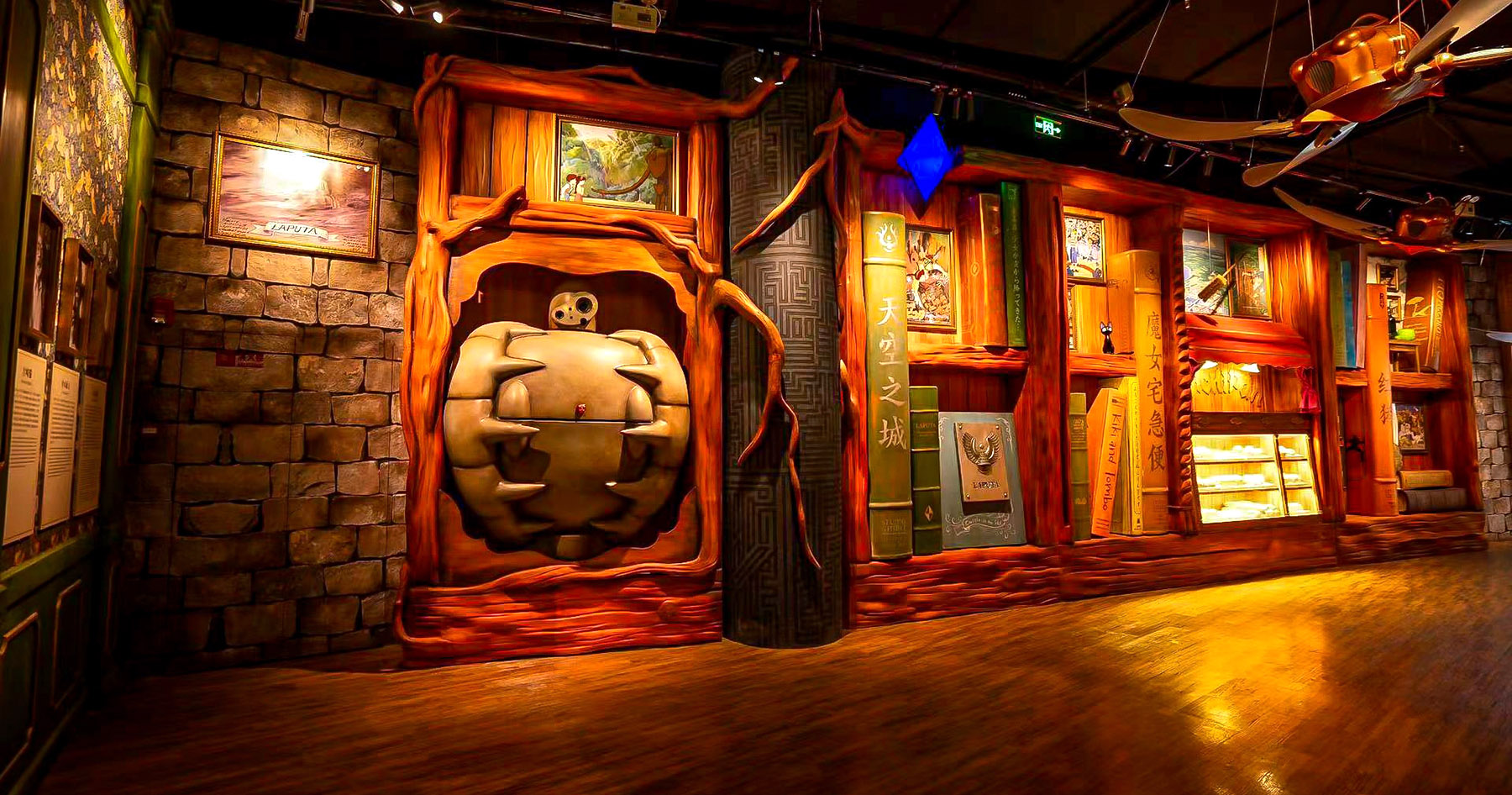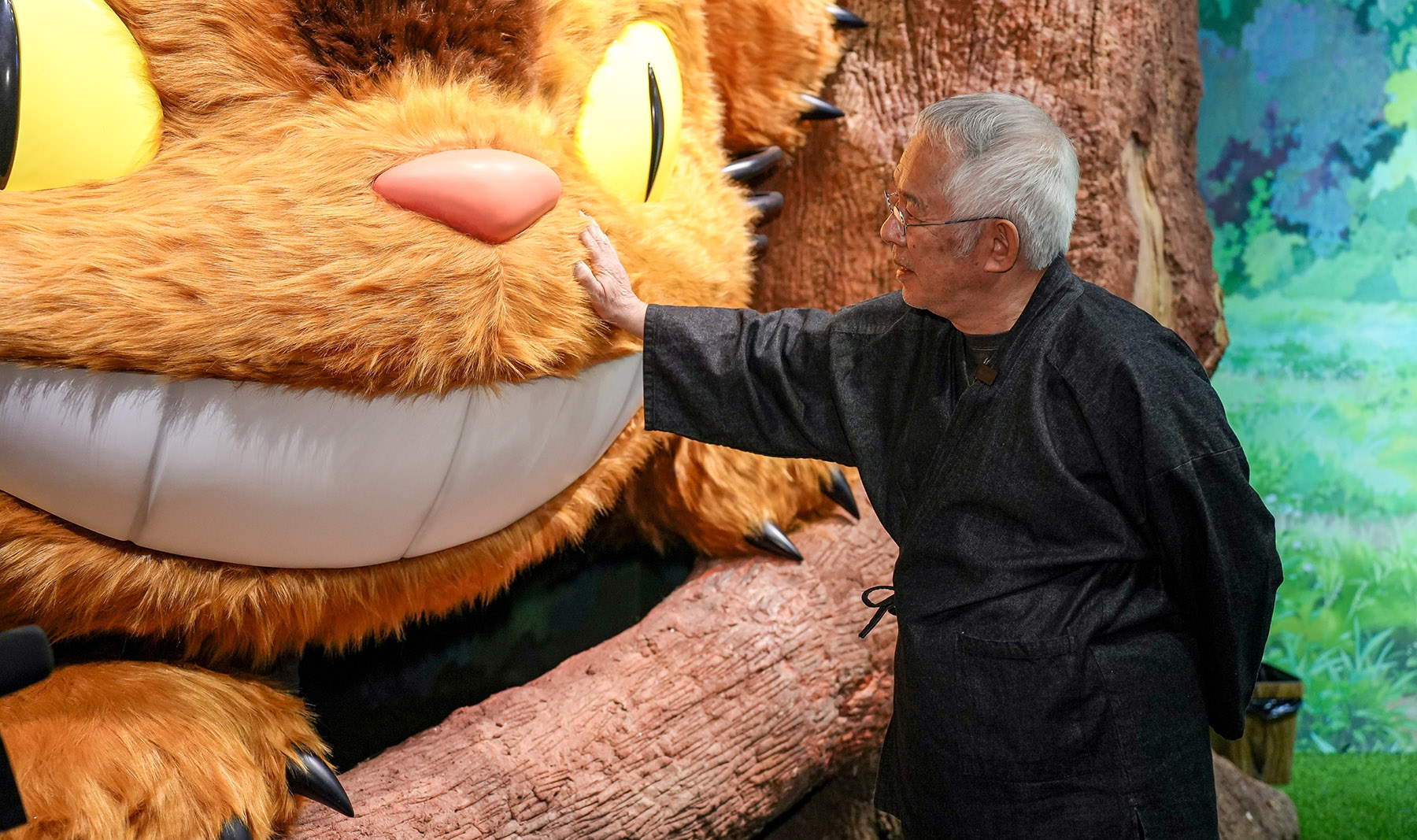Joint exhibition takes visitors to the fantastical worlds of Japan's beloved animator, Xu Fan reports.

Despite saying he would retire seven times, Japanese animation legend Hayao Miyazaki has never truly kept that promise. However, his lack of commitment has been good news for his fans.
The Boy and the Heron, the director's latest outing, and which earned him his second Oscar for Best Animation following Spirited Away in 2003, has grossed over 730 million yuan ($100.8 million), topped China's box office consecutively for two weeks between April 3, its opening day, and April 14.
There’s a divine feeling when the sunlight filters through the glass roof during the day, which deeply moves me.
Daisuke Nishikata, executive director of Studio Ghibli
For die-hard fans eager to delve deeper, an ongoing exhibition leads into some of the most iconic scenes from Miyazaki's movies, from the mysterious woodlands in Princess Mononoke to the bathhouse in Spirited Away.
Jointly organized by Chinese and Japanese partners, The Studio Ghibli Story Immersive Art Exhibition, the first of its kind in the country, kicked off on April 12 and will run until Oct 31 at the Shanghai International Media Port's Art Center.
The project, which took 122 days to mount, features 24 exhibit areas in three venues and covers 2,800 square meters in which 52 digital projects have been installed to create an immersive effect.
More than 10 Japanese craftsmen specialized in the polishing of props to make them appear aged and consistent with their period, were dispatched to Shanghai to help.

As they enter the venue, visitors will be greeted by a giant statue of Totoro, the beloved fantastical creature from the 1988 movie My Neighbor Totoro. Clutching a red umbrella much like the traditional Chinese oilpaper umbrella in one of its paws, the statue stands 6 meters tall, making it the largest of its kind in the world.
"Totoro has become a symbol of Japan, and the umbrella is a sign of China. We hope this design conveys our wish to enhance cultural exchange between China and Japan," says Motohiro Konoe, founder of Tsukuru Inc., which cooperated with Unlimited Art, the art brand of Chinese ticketing platform Damai, to organize the exhibit under the authorization of Studio Ghibli.
READ MORE: Without fanfare, anime master Miyazaki's likely final film opens
Konoe says it was finalized in a mere four months, even though an event of this scale typically requires seven months. The expedited timeline was chosen so that the exhibition could open simultaneously with the screening of The Boy and the Heron, which was originally scheduled for release on the Chinese mainland during the summer, he adds.
Konoe also says that the exhibition has been curated to appeal to the preferences of Chinese visitors, and incorporates many immersive elements.
The entrance to the exhibition hall is a tunnel made of fake printed "stones", that is filled with a sense of mystery. As visitors arrive, they can see the poster for the 1984 movie Nausicaa of the Valley of the Wind apparently suspended in midair, as if by magic. Set in a post-nuclear futuristic world, the film was one of the first to pave the way for Studio Ghibli's global fame.
Continuing inside is like traveling back in time, as fans see their favorite characters and settings from Miyazaki classics over the past 40 years emerge one after another.

Around one corner, visitors might encounter the robot from Laputa: Castle in the Sky (1986) hidden among towering trees, and walking down another path, they might come across the mouthwatering bakery from Kiki's Delivery Service (1989).
What might dazzle fans the most is taking the elevator to the main exhibition area that has been specially designed to display props and stills of The Boy and the Heron. Underneath the massive glass ceiling, dozens of "Warawara" — the white, blob-like spirit creatures from the movie's magical in-between world — are suspended, appearing to gently welcome them.
"Such a design has never been attempted in previous Japanese exhibitions. There's a divine feeling when the sunlight filters through the glass roof during the day, which deeply moves me," says Daisuke Nishikata, the executive director of Studio Ghibli.
Nishikata also reveals that The Boy and the Heron, which was released in Japan last July, has taken the shortest time of all Miyazaki movies to be released in China.
Saying that he has discovered that the director has a large fan base in China, Nishikata says that he wishes the exhibition and future cooperation with Chinese partners will bring more joy to Chinese audiences, and allow more people to get to know the studio founded by Japanese producer Yasuyoshi Tokuma in 1985.

An entire wall at the exhibition takes a retrospective look at Tokuma's dedicated attempts to boost cinematic exchange between China and Japan.
Known for discovering Miyazaki, it was Tokuma who appointed him as director of Nausicaa of the Valley of the Wind in 1984, propelling Japan's now most prestigious animator to fame and global recognition. In 1990, Tokuma arranged for Laputa: Castle in the Sky to be shown in China, making it the first Miyazaki movie to be shown in mainland cinemas.
When asked about what the company has taken from the experience, Yu Shuitao, brand manager for Damai's Unlimited Art, says that they have learned the Japanese spirit of craftsmanship.
She says that the exhibition features a hallway designed to showcase a collection of 600 books, brought from Japan by Studio Ghibli.
"Even the way we arranged the books was done in a manner that closely replicates the style of Studio Ghibli. Our Japanese partners paid great attention to every aspect," Yu explains.
ALSO READ: Animating the next generation
He Mi, president of Damai, says that the exhibition is the largest investment in a thematic exhibition in which Damai has ever participated or collaborated.
He says that the company has managed the complex procedure of organizing a Sino-Japanese exhibition on a very tight schedule, efficiently handling aspects such as importing props.
Yu adds that the Shanghai exhibition marks a good start for learning from the experience of international cooperation and hopes that it will help them organize exhibitions of work by Chinese artists in foreign markets in the future.
Contact the writer at xufan@chinadaily.com.cn


